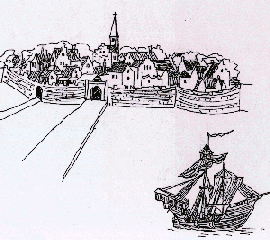Meet the Middle Ages
BackFortified towns

Many towns had a castle, with a garrison of soldiers to guard and protect it. Some tows were also surrounded by a ring-wall. Several Danish towns had ring-walls, because here there were many uprisings and civil wars and the townspeople needed to protect themselves against enemies, both from Denmark and from abroad.
In Norway, there were no towns with a ring-wall.
In Sweden, there were four towns with a ring-wall; Kalmar, Stockholm, Visby and Viborg. Why did these towns need a defence-wall more than other towns? All four were important ports and trade-centres. Kalmar was the southern-most town in Sweden and lay near the Danish border. Viborg was the last outpost of eastern Finland on the Russian border. Stockholm was the kingdom ´s most important town where the access to Bergslagen (a mining-district) was controlled. In Visby, many German merchants lived and did business. On rural Gotland, many of the peasants were also tradesmen or skippers. There was competition and sometimes enmity between the peasants and town merchants. The ring-wall around Visby was built by the townsmen as a protection against the country peasants.
The ring-walls had to withstand attacks by bows and by crossbows. Therefore, they were high and narrow, On the top, along the inside of the wall, there were wall-walks, allures, from were one could aim and shoot. There were also watchtowers which gave the soldiers a good view of enemy approaching. There were no large buildings or high trees nearby which would obstruct the view.